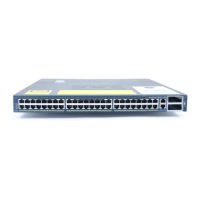226 Cisco LAN Switching Configuration Handbook
Tip Layer 2 CoS and Layer 3 DSCP/ToS are completely independent concepts. As such,
the two QoS values do not intermingle or automatically translate to each other. A switch
must map between CoS and DSCP values at a Layer 2 and Layer 3 boundary.
The Layer 3 DSCP/ToS is carried within each IP packet, allowing the QoS information to
be propagated automatically. The Layer 2 CoS is not contained in Layer 2 frames, however,
and can only be carried across a trunk. To propagate the CoS values, you must use a trunk
between switches.
Catalyst Switch Queuing
Catalyst switch ports have both ingress and egress queues. These buffer frames as they
are received or before they are transmitted. Each port usually has multiple queues, each
configured for a relative traffic priority. For example, the lowest-priority queue is serv-
iced only after the higher-priority queues.
Most switch platforms have a strict-priority queue that is used for time-critical traffic.
This queue is always serviced before any other queue on the port.
Each port queue usually has one or more thresholds that indicate when traffic can or can-
not be dropped. When the queue is less full than a threshold, frames are not dropped. If
the queue is filled over a threshold, the likelihood that frames can be dropped increases.
During QoS configuration, you must reference the queues by number. The lowest-priority
standard queue is always queue 1. The next-higher priority standard queues follow, begin-
ning with 2. The strict-priority queue always receives the highest queue index number.
Cisco Catalyst switch ports are described with the following queue type notation:
xpyqzt, where the notations indicate the following:
■ p: The number of strict-priority queues, given by x
■ q: The number of standard queues, given by y
■ t: The number of configurable thresholds per queue, given by z
For example, a switch port of type 1p1q4t has one strict-priority queue, one standard
queue, and four thresholds per queue. The low-priority standard queue is called queue 1,
whereas the strict-priority queue is called queue 2.
13-2: QoS Configuration
■ QoS operations and policies can be applied as follows:
■ Port-based: All data passing through a specific port. This is usually used on a
switch with a Layer 3 switching engine.
■ VLAN-based: All data passing through a specific VLAN on the switch. This is
usually used on a switch with a Layer 2 switching engine or when QoS policies
are common for all traffic on a VLAN.

